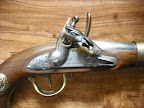When Sam Colt invented his revolving cylinder handgun 167 years ago in 1836, he revolutionized hand-to-hand combat in a manner that continues to this day with direct implications for U.S. troops preparing for combat against al Qaeda terrorists and Iraq.
Throughout the years since Colt's patent for the revolving-cylinder handgun, the U.S. military has viewed the handgun as both an offensive and defensive weapon. From the mid-1800s up through World War I, the handgun was viewed as the ultimate choice for close-quarter battle (particularly by the cavalry) over the saber and bayonet.
The original Colt Single-Action Army-chambered in 45 U.S. Army, varied slightly in loadings, but basically provided a 250-grain lead round-nose projectile, propelled by black powder to about 800 feet per second (fps). The performance of this original black-powder cartridge evolved out of the large-frame .44 cap-and-ball percussion pistols designed by Colt for the U.S. Army cavalry. The cavalry needed a gun that would knock down either a man or his horse, and the Walker .44 and later the S.A. A. 45 performed admirably in that capacity.

















